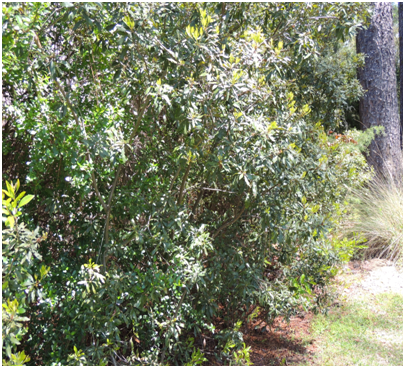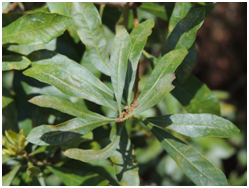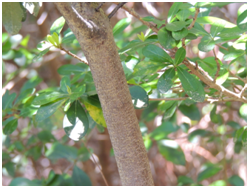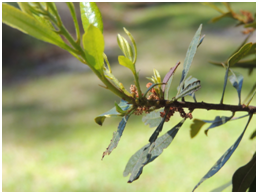Wax Myrtle
Myrica cerifera

(Photo by Brittany Mixon)
View the Location on Campus
Taxonomy(1,2)
Classification: Angiosperm, dicot
Family: Myricaceae
Common name: Wax Myrtle, Souther Wax Myrtle, Southern Bayberry
General Information(1,2)
Region of Origin: United States
USDA Plants Hardiness Zones: 7-10
Growth Habit: Shrub
- Size: 25 feet tall
- Deciduous/Evergreen: Evergreen
- Flowering: Late winter
Diagnostic Characteristics
Leaves(1)
- Other: Yellowish resin glands; 4.5 inches long, 2 inches wide

(Photo by Brittany Mixon)
Stem/Bark(2)
- Color: Grayish-white

(Photo by Brittany Mixon)
Flower(2)
- Perfect/Imperfect: Imperfect
- Color: Yellow-green (Male flowers)
- Inflorescence type: Catkins (Male flowers)
- Other: Dioecious

(Photo by Brittany Mixon)
Cones(2)
- Size: 1/8 inch
- Color: Gray
Horticultural Information(1,2)
- Light: Full sun to partial shade
- Moisture: Fairly wet soils
- Maintenance: Easy to care for
- Landscape Uses: Small tree or pruned shrub, around houses or buildings
- Other: Salt tolerant, avoid dry soil
Interesting Facts(2)
- The aromatic compounds in Wax Myrtle help to repel insects, including ticks.
- The waxy cones are a high energy food source for birds in the winter, attracting and holding migratory warblers.
References
1) Dirr, M. (1998). Manual of Woody Landscape Plants: Their Identification, Ornamental Characteristics, Culture, Propagation and Uses. Champaign, IL: Stipes Publishing.
2) Scheper, J.(2003). Myrica cerifera . Retrieved from http://www.floridata.com/ref/M/myrica.cfm
Prepared by Brittany Mixon as a course requirement for BIOL 3630/5630, Spring 2013
Edited by Jessica Bartek
Edited by Jessica Bartek
Department of Biology
-
Room 2035, 2nd Floor
Bailey Science Building -
Mailing Address
1500 N. Patterson St.
Valdosta, GA 31698 - Phone: 229.333.5759
- Fax: 229.245.6585
Monday - Thursday
8:00AM until 5:30PM
Friday
8:00AM until 3:00PM
Saturday - Sunday
Office Closed